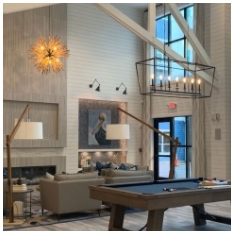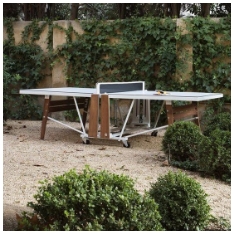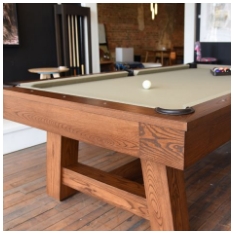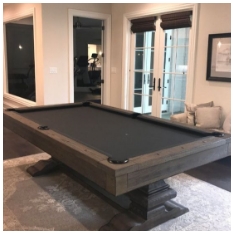Shuffleboard is a fun and engaging game that has been enjoyed by people of all ages for decades. Whether you're planning to add a shuffleboard table to your home or upgrading your current setup, choosing the right table is essential to enhance your gameplay experience. With so many options on the market, selecting the perfect shuffleboard table can seem overwhelming. But don't worry! This guide will walk you through everything you need to know to make the right decision.
What is Shuffleboard?
Shuffleboard is a game where players slide pucks down a long, smooth table, aiming to land them in scoring zones. The game requires skill and strategy, making it a great option for family gatherings, game nights, and social events. While traditional shuffleboard is played on a large court, home shuffleboard tables provide a more compact way to enjoy the game indoors.

Key Factors to Consider When Choosing a Shuffleboard Table
When you're in the market for a shuffleboard table, there are several important factors to consider to ensure you're making the right choice for your space and needs. Here are the key elements to keep in mind:
1. Size of the Table
The size of the shuffleboard table is one of the first things to think about when choosing the right one. Shuffleboard tables come in various lengths, with the most common sizes ranging from 9 to 22 feet. When selecting the size, consider both your available space and how many people you expect to play at once.
- Shorter Tables (9-12 feet): Ideal for smaller rooms or apartments, these tables accommodate 2-4 players. They are great for more casual gameplay.
- Medium Tables (14-16 feet): Suitable for larger game rooms or basements, these tables can host 4-6 players and offer a more competitive experience.
- Long Tables (18-22 feet): Best for spacious areas, these tables provide the most authentic shuffleboard experience and are great for hosting larger groups or tournaments.
Before making your decision, measure the space where the table will go to ensure a comfortable fit. You’ll want enough room around the table for players to move freely and for the pucks to travel the length of the table.
2. Material and Build Quality
Shuffleboard tables are typically made from wood, but the quality and type of wood used can vary significantly. When choosing a table, consider both the material and the build quality to ensure durability and stability.
- Wood Construction: Many shuffleboard tables are made from solid hardwoods like maple, oak, or walnut. These materials offer strength and longevity, but they can be quite heavy.
- MDF or Engineered Wood: Some more affordable options use MDF (medium-density fiberboard) or other engineered wood products. While these can be less expensive, they may not offer the same durability or aesthetic appeal as solid wood tables.
- Finish: The finish on the table is also important, as it impacts the appearance and ease of maintenance. Look for a table with a high-quality, smooth finish that will resist scratches and damage.
3. Playfield Surface
The playfield surface is where the action happens, and it's crucial to choose one that is smooth, level, and durable. A quality playfield will provide a consistent, fast surface for the pucks to glide over.
- Polymer Coating: Most modern shuffleboard tables feature a polymer coating, which creates a smooth and shiny surface. This type of coating helps to reduce friction and allows the pucks to slide more easily.
- Wood Surface: Some shuffleboard tables use a traditional wood surface, which may require more maintenance and care. Wood surfaces tend to be more susceptible to wear and tear, but they offer a classic look.
4. Scoring System and Accessories
Shuffleboard tables can come with different scoring options and accessories, which can add to the game’s enjoyment. Some tables feature built-in electronic scoring systems, while others have manual scoring options. When choosing a table, consider what kind of scoring system you'd prefer.
- Electronic Scoring: Ideal for a more modern, tech-savvy experience, electronic scoring systems keep track of the game automatically. This is especially helpful for players who are new to shuffleboard or those who prefer a hands-off approach.
- Manual Scoring: Classic shuffleboard tables often include a manual scoring system, typically using abacus-style counters or chalkboards to track points. These tables offer a more traditional feel and may appeal to players who enjoy the nostalgic aspect of the game.
In addition to scoring, make sure your shuffleboard table comes with all the necessary accessories, such as pucks, wax or powder for the playing surface, and maintenance tools. Some tables may include these accessories, while others may require you to purchase them separately.
5. Price Range
Price is an important factor to consider when selecting a shuffleboard table. While there are options available for every budget, it's essential to balance your desire for a high-quality table with what you're willing to spend.
- Budget Tables: If you're on a tight budget, you can find smaller shuffleboard tables made from MDF or engineered wood. These options are usually affordable and can still provide an enjoyable playing experience.
- Mid-Range Tables: Mid-range tables often feature solid wood construction and better-quality playfields. These tables typically offer a good balance between affordability and durability.
- High-End Tables: High-end shuffleboard tables are usually made from premium materials, such as solid hardwoods and professional-grade surfaces. These tables can be quite expensive, but they offer top-tier performance and aesthetics.
6. Aesthetic Appeal
Shuffleboard tables are a centerpiece in any game room or entertainment space, so you'll want to choose a table that complements the style of your room. Shuffleboard tables come in a range of designs, from sleek and modern to traditional and rustic.
- Modern Designs: These tables often feature minimalist designs with clean lines and contemporary materials. If you prefer a more modern aesthetic, look for shuffleboard tables with metal accents or sleek finishes.
- Traditional Designs: If you prefer a more classic look, consider a shuffleboard table made from solid wood, such as oak or walnut, with detailed craftsmanship and elegant touches.
7. Brand Reputation and Reviews
Before making your purchase, be sure to research the brand and read reviews from other customers. A reputable brand with positive reviews is more likely to provide you with a high-quality product and good customer service. Checking online reviews or asking for recommendations from friends or fellow shuffleboard players can give you valuable insight into the table's quality and performance.
Conclusion
Choosing the perfect shuffleboard table for your home involves considering factors like size, material, playfield quality, and accessories. By carefully assessing your space, budget, and aesthetic preferences, you can find a table that suits both your gameplay style and your home decor. Whether you're a casual player or a competitive enthusiast, investing in a high-quality shuffleboard table will bring hours of fun and excitement to your home. Start your search today and get ready to enjoy endless shuffleboard games with friends and family!





